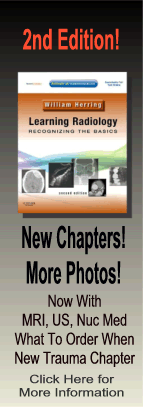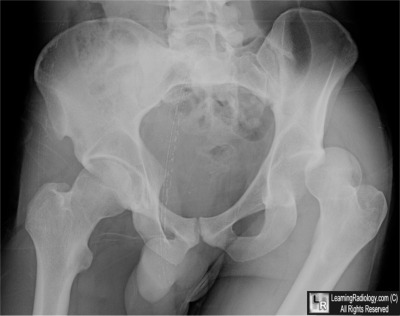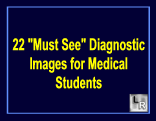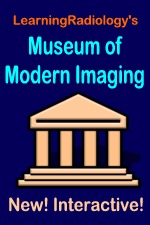| Cardiac | |
|---|---|
| GI | |
| Bone | |
| GU | |
| Neuro | |
| Peds | |
| Faculty | |
| Student | |
| Quizzes | |
| Image DDX | |
| Museum | |
| Mobile | |
| |
Misc |
| Videocasts | |
| Signs | |
Learning
Radiology:
Recognizing
the Basics
Available
on the Kindle
and IPad
LearningRadiology Imaging Signs
on Twitter
![]()
Follow us on
What is the most likely diagnosis?
- 37 year-old in motor vehicle accident
- Bladder Rupture
- Pelvic Fracture
- Central Dislocation
- Posterior Hip Dislocation
- Anterior Hip Dislocation
Additional Images-None
![]()
Additional Images
None
![]()
Answer:
4. Posterior Hip Dislocation
More (Click Discussion Tab)
Posterior Hip Dislocation
General Considerations
- Hip dislocation accounts for only 5% of all dislocations
- Posterior hip dislocations are much more common than anterior hip dislocations (90% to about 10%)
- Mechanism in posterior dislocation classically is unrestrained occupant of a motor vehicle accident, especially collisions which are head-on, in which the flexed knee strikes dash with hip flexed and adducted
- Force is transmitted from the foot or ankle along femoral shaft to the hip
- Associated with fractures of the posterior rim of the acetabulum
MORE . . .
.
This Week
37 year-old in motor vehicle accident |
Some of the fundamentals of interpreting chest images |
The top diagnostic imaging diagnoses that all medical students should recognize according to the Alliance of Medical Student Educators in Radiology |
Recognizing normal and key abnormal intestinal gas patterns, free air and abdominal calcifications |
Recognizing the parameters that define a good chest x-ray; avoiding common pitfalls |
How to recognize the most common arthritides |
LearningRadiology
Named Magazine's
"25 Most Influential"
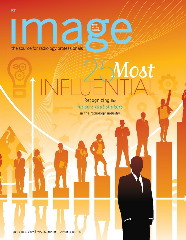
See Article on LearningRadiology
in August, 2010
RSNA News
| LearningRadiology.com |
is an award-winning educational website aimed primarily at medical students and radiology residents-in-training, containing lectures, handouts, images, Cases of the Week, archives of cases, quizzes, flashcards of differential diagnoses and “most commons” lists, primarily in the areas of chest, GI, GU cardiac, bone and neuroradiology. |

